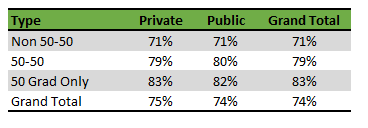 Something happened this weekend that most families trying to figure out how to pick and pay for college missed–and most colleges are probably good with this. This weekend the government released a revised College Scorecard that lets users filter schools based on graduation rates, average annual costs, and graduate median salary. Better yet, all the data collected (although not necessarily used) by the College Scorecard was also released for downloading. Guess what I’ve been doing since Sunday?
Something happened this weekend that most families trying to figure out how to pick and pay for college missed–and most colleges are probably good with this. This weekend the government released a revised College Scorecard that lets users filter schools based on graduation rates, average annual costs, and graduate median salary. Better yet, all the data collected (although not necessarily used) by the College Scorecard was also released for downloading. Guess what I’ve been doing since Sunday?
It’s a lot of data and I’m still trying to cut it down to a manageable size. But it’s Thursday and I need to generate my 50-50 Highlights list and I want to show something new about the data. So I decided to go for what I thought would be an easy post, looking at the percentage of students who were earning more than $25,000 after 10 years in the workforce. The $25,000 is based on the median income of the average high school graduate.
In other words, what percentage of college graduates are better off than if they hadn’t attended college at all.
I could have chosen the average income for graduates but I thought that would bring in the entire majors argument and I wanted something simple.
Also, I like the concept of a minimum threshold. It reminds me of what the Education Trust is doing in terms of holding colleges accountable. They are targeting the lowest performers by setting bare minimum standards.
Granted, we talking about setting pretty low benchmarks here. It would be like evaluating cars on whether or not they actually moved rather than how fast they can go. But if you’re going to buy a car, it’s reasonable to expect it to get you from point a to point b.
Looking at the income threshold is the same sort of approach. Despite all of the other non-economic advantages of going to college, it’s reasonable to expect that college graduates will be better off economically than those with just a high school degree.
Of course, this doesn’t take into account the amount spent on education, the loss of income while in college, and the limitations of the data itself.
But it can get you thinking.
I looked at the average percentage of graduates earning over $25,000 after working ten years for the 50-50 schools. I also calculated the average for non-50-50 schools. These I split into two categories. Those schools that schools didn’t meet the graduation rate or acceptance requirements I labeled non 50-50. The 50-grad only schools met the graduation rate requirement but not the acceptance requirements. The following table shows the results.

As you can see, there are some differences between the three groups. I have no idea if the differences are statistically significant or not. What I take away from it is that most schools are in the same ballpark in terms of the percentage of students earning more than $25,000.
This isn’t to say that the percentages don’t matter. If you come across schools with lower numbers, you’ll want to know why. You would expect some schools to have lower numbers because of the type of jobs the graduates pursue–often the reason the graduates attended the school in the first place.
In some ways, I think this information says more about businesses than colleges. Rather than develop meaningful training programs for potential employees, it’s easier to just require students to pay for a college degree. The fact that around 25% of college graduates don’t earn more than high school graduates lends support to the argument that a college degree has just become the “new” high school diploma.
If nothing else, the numbers should make us stop and think about the value of pushing everyone to go to college. In one way, it makes sense if a college degree is the new minimum standard.
Yet, there’s another possibility that we have to consider. Maybe our economy doesn’t appropriately value a significant amount of work that actually requires a college degree to perform. However, if society recognizes the value of the work, does that mean we should pay more for the work or lower the cost of the education needed to perform it?
But what about this week’s list? The tables below show the top 30 and bottom 30 50-50 schools by percentage of graduates earning more than $25,000 about 10 years of working. The data represent only students who received some sort of federal financial aid, including loans. As usual, the four-year rate is used for private schools the five-year rate for public.
(Download PDF version)
Top 30 50-50 Colleges Ranked by Percentage of Graduates
Earning over $25,000 After 10 Years
| Name | Type | State | Full- time Under- grads | 4/5 yr Grad Rate | % Freshman Receiving Pell Grants | % Graduates earning over $25,000 after 10 years |
|---|---|---|---|---|---|---|
| Rose-Hulman Institute of Technology | Private | IN | 2186 | 66 | 17 | 93.8 |
| Villanova University | Private | PA | 6547 | 86 | 14 | 92.3 |
| Fairfield University | Private | CT | 3546 | 79 | 13 | 92.2 |
| Worcester Polytechnic Institute | Private | MA | 3959 | 70 | 14 | 91.1 |
| University of the Sciences | Private | PA | 1814 | 67 | 31 | 90.9 |
| Bryant University | Private | RI | 3200 | 78 | 16 | 90.8 |
| Stonehill College | Private | MA | 2458 | 82 | 17 | 90.6 |
| Saint Johns University | Private | MN | 1850 | 71 | 18 | 90.6 |
| Massachusetts Maritime Academy | Public | MA | 1333 | 64 | 19 | 90.5 |
| Clarkson University | Private | NY | 3084 | 61 | 29 | 89.9 |
| Providence College | Private | RI | 3798 | 83 | 15 | 89.6 |
| Loyola University Maryland | Private | MD | 3951 | 79 | 15 | 89.5 |
| Western New England University | Private | MA | 2498 | 52 | 29 | 89.5 |
| Georgia Institute of Technology-Main Campus | Public | GA | 13291 | 76 | 14 | 89.4 |
| Maine Maritime Academy | Public | ME | 979 | 72 | 22 | 89.4 |
| Marquette University | Private | WI | 8046 | 57 | 17 | 89.1 |
| Santa Clara University | Private | CA | 5338 | 77 | 12 | 89.0 |
| Creighton University | Private | NE | 3815 | 67 | 19 | 88.8 |
| Gustavus Adolphus College | Private | MN | 2423 | 81 | 24 | 88.6 |
| Missouri University of Science and Technology | Public | MO | 5472 | 56 | 24 | 88.2 |
| Illinois Wesleyan University | Private | IL | 2001 | 72 | 22 | 87.8 |
| Quinnipiac University | Private | CT | 6307 | 72 | 15 | 87.7 |
| Saint Anselm College | Private | NH | 1878 | 71 | 14 | 87.7 |
| Randolph-Macon College | Private | VA | 1295 | 57 | 26 | 87.6 |
| Assumption College | Private | MA | 2022 | 70 | 24 | 87.5 |
| Virginia Polytechnic Institute and State University | Public | VA | 23512 | 80 | 15 | 87.2 |
| Saint Joseph's University | Private | PA | 4489 | 70 | 11 | 87.0 |
| University of Illinois at Urbana-Champaign | Public | IL | 31516 | 82 | 21 | 86.9 |
| California Maritime Academy | Public | CA | 1008 | 57 | 26 | 86.7 |
| Drake University | Private | IA | 3185 | 61 | 16 | 86.7 |
Bottom 30 50-50 Colleges Ranked by Percentage of Graduates
Earning over $25,000 After 10 Years
| Name | Type | State | Full- time Under- grads | 4/5 yr Grad Rate | % Freshman Receiving Pell Grants | % Graduates earning over $25,000 after 10 years |
|---|---|---|---|---|---|---|
| Bennington College | Private | VT | 609 | 58 | 19 | 52.4 |
| Kansas City Art Institute | Private | MO | 735 | 57 | 38 | 53.0 |
| Lancaster Bible College | Private | PA | 814 | 54 | 39 | 58.5 |
| Keiser University-Ft Lauderdale | Private | FL | 12007 | 59 | 73 | 58.7 |
| Hampshire College | Private | MA | 1492 | 56 | 15 | 59.2 |
| Maryland Institute College of Art | Private | MD | 1759 | 67 | 23 | 60.3 |
| Columbia International University | Private | SC | 511 | 52 | 42 | 60.7 |
| The Evergreen State College | Public | WA | 3766 | 53 | 32 | 61.0 |
| The University of the Arts | Private | PA | 1860 | 57 | 33 | 61.1 |
| Ringling College of Art and Design | Private | FL | 1212 | 56 | 23 | 63.9 |
| Grace College and Theological Seminary | Private | IN | 1274 | 54 | 42 | 63.9 |
| Cazenovia College | Private | NY | 937 | 53 | 47 | 64.2 |
| The New School | Private | NY | 5878 | 50 | 26 | 64.9 |
| Massachusetts College of Art and Design | Public | MA | 1677 | 71 | 28 | 65.2 |
| Asbury University | Private | KY | 1326 | 56 | 48 | 65.7 |
| Northland College | Private | WI | 538 | 52 | 47 | 65.7 |
| Cleveland Institute of Art | Private | OH | 558 | 54 | 51 | 65.8 |
| Mills College | Private | CA | 922 | 53 | 42 | 66.1 |
| Dean College | Private | MA | 1076 | 62 | 39 | 66.7 |
| Wells College | Private | NY | 524 | 56 | 56 | 66.9 |
| Earlham College | Private | IN | 1045 | 59 | 34 | 67.2 |
| Salem College | Private | NC | 827 | 61 | 51 | 67.2 |
| Castleton State College | Public | VT | 1854 | 49 | 34 | 67.8 |
| Sarah Lawrence College | Private | NY | 1441 | 62 | 14 | 67.8 |
| Goshen College | Private | IN | 745 | 54 | 32 | 67.9 |
| University of Northwestern-St Paul | Private | MN | 1958 | 51 | 38 | 68.1 |
| Reed College | Private | OR | 1356 | 70 | 18 | 68.4 |
| Huntington University | Private | IN | 960 | 57 | 36 | 69.1 |
| Taylor University | Private | IN | 1852 | 65 | 24 | 69.2 |
| Converse College | Private | SC | 671 | 55 | 44 | 69.2 |
| Massachusetts College of Liberal Arts | Public | MA | 1353 | 54 | 48 | 69.3 |

1 thought on “50-50 Highlights: Is Your College Degree Worth More Than a High School Diploma?”